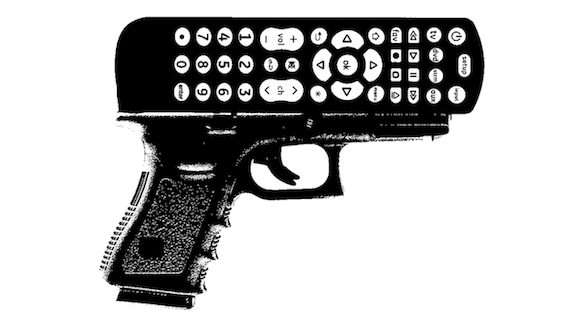When Is a Gun Like a TV Remote?

During a training in Dallas, I visited my parents who live there, but whom I rarely get to see on account of living, working, and training in San Diego most of the year. While relaxing at their house between extended training sessions an incident occurred that got me thinking.
We had all decided to sit down and watch a movie, but my nephew, a toddler at the time, had recently been over to play and had moved the television remote control to an unknown location, as he is wont to do. My parents and I summoned what was left of our energy reserves to mount a thorough search of the house to no avail. I reluctantly suggested that we just go over and turn on the TV by hand and then manually select a movie.
It was at this point that my parents informed me that they did not believe manufacturers even put manual controls on new TVs — “Everyone just uses the remote these days,” they said. In utter disbelief I walked over to the set and scanned the edges around the front, along the side and just behind the display until I finally found what I was looking for. In the back there was a vestigial control panel with limited options that would not provide us access to some of the higher-end functions that were exclusively remote-driven, but would allow us to accomplish our basic goal: to turn it on, select a movie (any movie at this point) and relax my aching body on their very, very comfortable couch. With that done, I dissolved into that couch and tried to remember what it was like before the remote control.
Back in the day, if you wanted to turn your TV on or off, or even watch a different channel, you had to get up off your asset and physically go over to manipulate the controls by hand. As a result of this fact people tended to be more patient with whatever was on. Then along came the remote control to remove all that work. Soon, we became much more casual about changing the channel, and before long we became completely reliant on remotes to the point that TV manufacturers stopped putting manual controls on the front of TV sets. In fact, most people today, including my family, would probably tell you that you can’t actually operate their TV without the remote — however, if you know where to access the manual controls, you can still execute the basic functions of any TV set in the catastrophic absence of that remote.
In a way, firearms are analogous to the venerable TV remote control. Like the remote, firearms distill, into a handheld device, all of the hard work and intent normally required to motivate a person to the point that they are willing to take action — and all that control is at their very fingertips. Furthermore, as firearms have gone into mass production in recent history, people have become so reliant on these highly efficient labor-saving devices that they have forgotten how to roll up their sleeves and do that work by hand when necessary. It might even be said that modern people are incapable of implementing the tool of violence without a firearm. Sound familiar?
The truth is that firearms don’t accomplish anything that you can’t already do by hand with a little knowledge and elbow grease, and there is nothing inherently special about them — unless it has become your only solution to asocial violence. In the rare event that you are put in a position that requires direct action to take out a threat you can’t afford to waste time and opportunity desperately searching for your labor-saving device.
Keep in mind that you come from a legacy of violence: By necessity, your ancestors knew the principles of violence and implemented them serviceably when necessary — or you wouldn’t be here. Luckily for us not much has changed since the dawn of time. Gravity is still cruelly tugging our bones toward the unforgiving surface of the planet, the human machine remains just as vulnerable in spite of all our efforts, and the old “rock to the back of the head” is just as relevant today as it was for our ancestors’ ancestors. Handguns are just a little smaller, a little more convenient, and require nearly zero training and intent to cause objective injuries.
Weaponizing your skeleton is simply a matter of training in the core principles of violence. One of the great benefits of training is that it allows you to take control of the learning environment before it’s an emergency. And, with a little training, anyone can learn to hurl their mass through vulnerable anatomy. Nothing has changed in that regard. When you have a principle-based approach to navigating true asocial violence — with and without tools — you’ll never be unarmed again.
— Taylor Good


All too true and it’s sad how these labor saving device (firearms) can affect how we deal with interpersonal conflicts in a more negative manner without the critical thought processes needed to muster the energy for physicality. But even still there are plenty of seemingly senseless physical attacks in society. Best to be prepared for most anything a human can do.
Agreed. On one hand we’re lamenting the vestigialization of basic life skills and on the other we’re recognizing a refinement of technology so profound that it’s possible for it’s “operator” to remain wholly dissociated from the physics. It reminds me of the Dan Carlin podcast where he’s referencing the opening salvos of the Great War and how detached from reality the strategies were at the beginning; having not accounted for the technological advancements that had happened between the last war(s) and their present. That cat’s not going back into the bag.